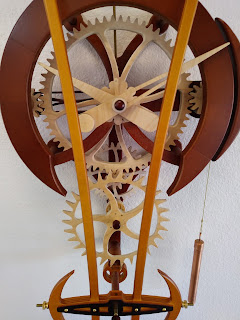 |
| Mantis by Clayton Boyer |
Mantis has a large, slow, two second beat compound balance pendulum. The pendulum on Mantis is about 46" (117cm) making it actually longer than a regular straight, hanging seconds pendulum, which are usually around 42" (107cm). However to get a straight, hanging pendulum to tick at a two second beat, that pendulum would have to be over thirteen feet long. Because Mantis uses a compound balance pendulum, we were able to create not only a dramatically shorter pendulum, but one with an artistic flare that beautifully accents this clock.
Mantis has a special escapement that allows for a very large and dramatic pendulum arc. With its pendulum swinging with about forty degrees of arc, it makes Mantis as much a kinetic sculpture as it is a clock. The way the Mantis escapement is designed helps modulate its tone and creates a slow, gentle "tick" with each contact with an escape wheel tooth. The slow swing and gentle sound of the pendulum is relaxing and mesmerizing, and the movement is a delight to view.
 |
| Mantis by Clayton Boyer |
Hiding behind the mobile crescent at the right side of the dial ring is a motorized remontoir making daily rewinding of this beautiful sculpture unnecessary. The clock is powered by a weighted motor arm that automatically rewinds the clock. The amount of drive weight is adjustable by simply changing the amount hanging from the cord on the right of the clock. The difficult part for me was determining what to hang there. There are so many beautiful options. I tried various rocks (which looked pretty nice), glass spheres, a painted fishing weight, and finally settled on the clean look of copper tube. That tube weighs 3.6oz (102gm), and to avoid over stressing the motor, the amount of added weight drive should be 8oz (227gm) or less. The rewinding of the remontoir motor arm is powered by an onboard nine volt battery which will keep the clock running for about three to four months.
Mantis has movement throughout its design - from the massive swing of the pendulum, to the remontoir motor arm actuating the bobblehead and crescent that accent Mantis' "broken" dial ring. The Organic clock design also has a "broken" dial, however that design is mainly aesthetic. The dial ring of the Mantis is "broken" for a different reason - which is to allow the viewer a better view of the internal workings of this sculpture.
Mantis was named because of the similarities between the antennae of a praying mantis and the upper part of the Mantis' double split pendulum. As it happened, the day before the Mantis was completed we were surprised to see that the Mantis clock had been visited by its namesake, a praying mantis. Shown going for a ride on the bobblehead in the picture below. The praying mantis spent the night hanging out on the bobblehead, however I still needed to add the decorative brass screws, so I moved him/her to the nearest rosebush. Obviously, such serendipity must equate, in some way, to a celebrity endorsement!
 |
| A Mantis on Mantis |

